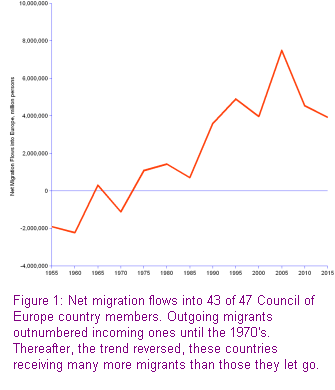
|
Insight : Migrations |

|
|
You are here: areppim > Society > Migrations
Migrations: the crowds at the gates
 EU (European Union) officials seem greatly concerned with the presence of crowds of would-be migrants at the gates of fortress Europe. On 18 June 2008, the EU Commission obtained the approval by the European Parliament of a draft directive ruling the conditions under which illegal migrants should be detained and "returned" to their country of origin. The directive prescribes, among other measures, the confinement of migrants without regular residence and work permits for a period of up to 18 months, preceding their eventual eviction, and a 5-year ban from EU territory.
EU (European Union) officials seem greatly concerned with the presence of crowds of would-be migrants at the gates of fortress Europe. On 18 June 2008, the EU Commission obtained the approval by the European Parliament of a draft directive ruling the conditions under which illegal migrants should be detained and "returned" to their country of origin. The directive prescribes, among other measures, the confinement of migrants without regular residence and work permits for a period of up to 18 months, preceding their eventual eviction, and a 5-year ban from EU territory.
Should these harsh regulations be adopted by the EU, do they suffice to stop the immigration flow?
The Atlantic waters surrounding the Canary Islands, the Mediterranean near Italy or the Moroccan sands near the Spanish enclaves have witnessed hair-raising drama, punctuated with agonizing suffering and horrifying death of people attempting to find a better way of life in Europe. However, uncertainty, pain and fear are not a powerful enough deterrent for people who consider that they have nothing to lose.
For each group of would-be migrants who meet death in the attempt, new crowds of poor people move forward and keep on trying. An undefined number are successful and, provided the economy moves at its cruise speed, they are readily employed by European businesses avid for cheap labour, and struggling with shortage of manpower.
An estimated 200 million people worldwide, equivalent to some 5% of the total population, have left their country of origin to try and live somewhere else. A calculation of net migration flows (defined by the UN as the number of incoming international migrants less outgoing international migrants) for 43 out of the 47 Council of Europe country members (Andorra, Liechtenstein, Monaco and San Marino excluded for lack of data) suggests unequivocally that there is a definite trend towards an ongoing inflow of migrants in Europe (see enlarged chart):
- in 1955, those 43 countries were losing 1.9 million people for other regions;
- in 2005, they were receiving a net inflow of 7.5 million people.
- in 2010, UN projections say they will be receiving 4.5 million.
- in 2015, in spite of all efforts to control the tide, projections still indicate a net inflow of 3.9 million people.
The trend is likely rooted in the social and economic fundamentals of the European world. Repressive directives, however rough, may prove quite ineffective. After all, human migration is an invariant of the species, and migration patterns are recurrent throughout history:
- 1 million years ago: migration of Homo erectus from Africa to Eurasia;
- 150 to 40 thousand years ago: migration of Homo sapiens from Africa to Asia, Australia, Europe and Americas;
- 300 to 500 AD: the Great migrations of the Germanic peoples;
- 18th & 19th century: migration of Europeans to North America.
Can a bureaucratic directive call a halt to such an age-old tropism? Assuming it can, would it actually be a good thing?
(Source of the data: United Nations - UNdata)
Download


 Go toTop
Go toTop
 Home
Home